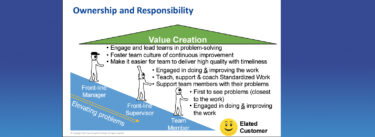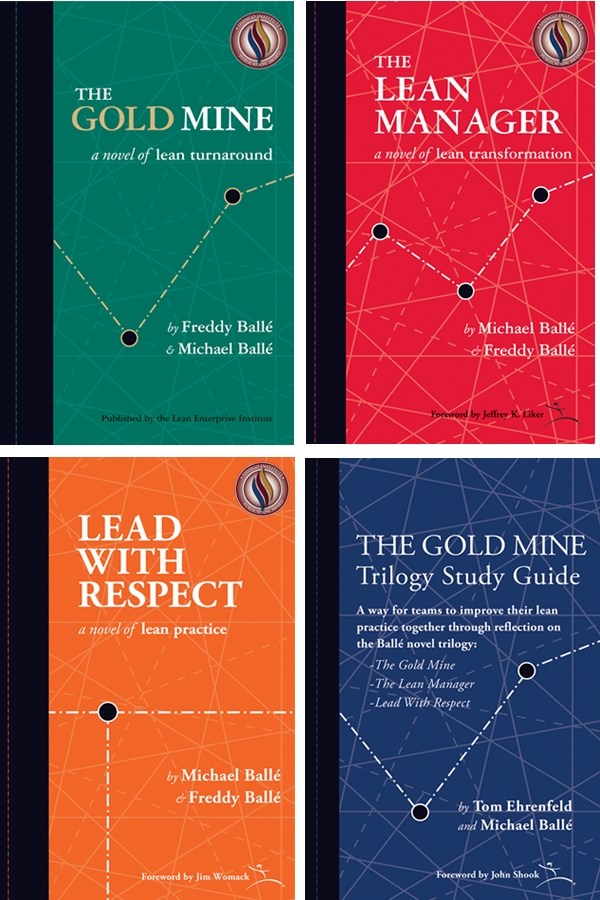The very term “governance” seems somewhat antithetical to lean. Yet effective governance, or at least the confluence of good lean leadership and project management, is critical to the success of any transformation effort.
Admittedly, when I think “governance,” I see a caricature of mature (read: old), MBO-mindset people in a conference room, sequestered miles from the gemba, reviewing stale implementation plans and interrogating folks on the reasons for missed milestones…and then telling them to just get it done.
Fortunately, that’s not what I’m talking about.
Over my 20-plus years of lean learning, I’ve witnessed a lot of implementation failures (heck, I may have even caused some of them). More than a few of these were due, at least partly, to a vacuum of good governance.
From my experience, a typical slow-motion train wreck often plays out like this:
- Leadership is aligned relative to the important stuff like True North, the organization’s big problem to be solved, mindset gap closure, pilot scope and measurable targets.
- The steering committee is identified and commissioned.
- A solid cross-functional team, led by an able value stream manager, maps the pilot value stream and generates an aggressive, but reasoned, value stream improvement plan (VSIP) to achieve the measurable targets, set the foundation for the implementation of a lean management system and organizational learning, and so on.
Everything seems pretty awesome so far, right? Not so fast…
- VSIP projects, kaizen events, and just-do-its are executed somewhat according to plan. VSIP measurable targets in areas like lead time, inventory, and rolled throughput yield are moving; but not necessarily in the right direction or with the planned velocity.
- The value stream manager starts sounding like Scotty from Star Trek: “She canna take anymore, captain.” [Note: I am not a Trekkie.]
- As other stakeholders run into barriers – often technical, organizational, or human resource development-oriented – they start sounding like a cynical Scotty: “Aye, and if my grandmother had wheels, she’d be a wagon.” [Note: Really, I am not a Trekkie.]
And it turns out that the steering committee, the proverbial guiding coalition of this change management effort, has not been meeting regularly or conducting its own critical leader standard work (LSW). Furthermore, these folks missed opportunities to do a key job of the lean leader: to coach and develop.
So what went amiss?
Here are four potential areas of concern along with some possible countermeasures, most which are inter-related.
- Blindness. On one recent project, I facilitated a mid-pilot reflection meeting with a group of leaders from a manufacturing client. With refreshing self-awareness and humility, they prepared a problem-solving A3 entitled, “Effective Governance.” They are on the path to lean transformation. That, however, is more the exception than the norm. Most leaders are transfixed on the technical aspects of lean. If, perchance, their lean implementation scope extends appropriately to the behavioral realm, it is often considered germane (only) for everybody else. Consistent with that mindset, governance and change management are regularly assumed self-possessed competencies. I mean, if you’re a leader, how could you NOT be good at that stuff?
- Possible Countermeasure: Do not take competencies for granted. Conduct formal governance training within the context of the lean transformation plan. Follow that up with a coach’s direct observation/feedback of one or more steering committee meetings.
- Identity crisis. More specifically, this is one in which the “governors” are unclear about the purpose of their transformation role: “Doesn’t someone else deal with that?”In fact, I have witnessed more than a few executives try to dump this hot potato onto the lean support office’s lap. Mission success is near impossible if one does not grasp the mission.
- Possible Countermeasure: Explicitly define the mission, roles and responsibilities with the stakeholders – not just for the steering committee but the champion, value stream manager, lean support office and project manager, as appropriate.
- Standard/leader standard work gap. Even though this happened almost ten years ago, I still vividly recall the incredulous look I got from a senior leader who was participating in a LSW development activity, accompanied by, “You don’t expect meto do this (LSW), do you?” I assured her that I did. Fortunately, many understand that LSW includes gemba walks, reflection meetings/huddles, andon responses, and even one-on-one coaching. However, leaders sometimes forget that LSW can cover the checkpoint process for subjects like VSIP, strategy deployment and development projects. Consequently, the checkpoints may suffer the ills of any non-standardized process.
- Possible Countermeasure: Develop and implement checkpoint standard work that defines the rigor and format by which people review their plans and performance versus measurable, time-based targets; highlight gaps, root causes, and countermeasures; report on countermeasure status, and flag barriers that they need help breaching. LSW must be infused with standardize-do-check-act thinking, through which lean leaders assess both adherence to the checkpoint SW and its ability to achieve its goals. For example, perhaps they find that the checkpoint cadence isn’t frequent enough for VSIP stakeholders to recognize and respond to gaps quickly.
- Under-developed lean leadership behaviors. LSW is not truly fruitful unless it is animated by good coaching. Coaching drives effective results and develops the problem-solving capability and continuous improvement orientation of those within the organization. Unfortunately, especially in a newly lean organization, behaviors may tend more towards the leader-as-fixer or it’s-all-about-results-and-damn-the-process end of the continuum. Invariably, many value stream leaders and value stream loop leaders need coaching relative to problem identification and problem solving, including help on how to negotiate the organizationally horizontal and vertical challenges. Sometimes these folks will need direct intervention and aid to address barriers for which the countermeasures are beyond their reasonable authority or influence. To illustrate, VSIPs and value stream performance have a definite PDCA dynamism. When developing the VSIP, we often don’t fully grasp the causal relationship between kaizen bursts and compression of lead time, the level of organizational resistance to the adoption of standard work, the effects of excessively wide leadership control on LSW and coaching effectiveness, etc.
- Possible Countermeasure: Coach the leaders on how to coach, both through classroom and real-life application, employing direct observation and feedback based largely on the Socratic method.
At this point, you may (still!) be thinking that there are a lot of things in the lean realm that are sexier than governance – and I totally agree.
Nevertheless, better and more thoughtful governance will improve the effectiveness of your lean transformation and help propagate lean thinking.
What’s been your experience?






